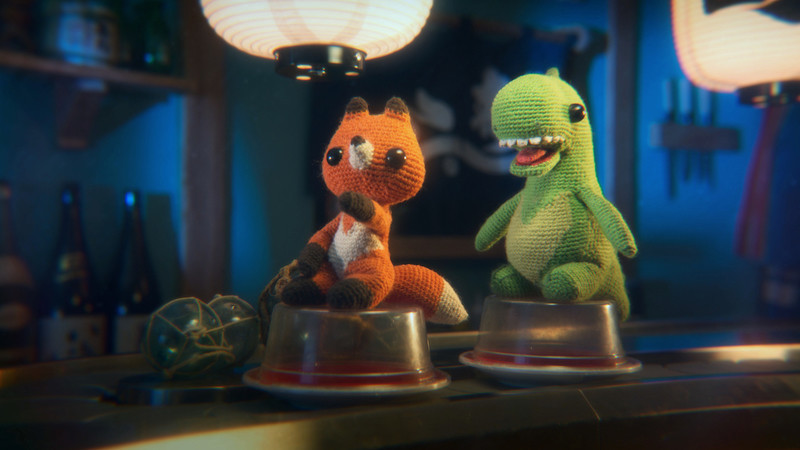
Andrew Goldsmith and Bradley Slabe’s stop-motion animated “Lost & Found” is the kind of tear-jerking crowd-pleaser one would expect to find at the front of a Pixar feature, which I mean as a high compliment. The film features two characters—a fox and a T-rex—who share a love so deep that, in fact, they each know what it takes to sacrifice one’s self for the other. I’ll say no more about that.
The two exist in a Japanese restaurant, their love and friendship captured via an anonymous camera phone with pictures of them playing and enjoying one another’s company. When the T-rex wakes up, he sees the fox standing on the edge of a fountain, throwing coins in. When the fox falls into the fountain, the T-rex must figure out a plan to save his friend from certain death.
Goldsmith and Slabe’s eight-minute short skillfully condenses its story to its most basic elements while keeping the audiences on the edge of their seats. It also helps that the characters are adorable and have dimension given their limited facial expressions. By the end, the viewer feels invested in these characters and one hopes we’ll see more from them. “Lost & Found” is easy to recommend to anyone looking for a short dose of Pixar-level emotional storytelling mixed with Laika-level stop-motion technique.

How did this story come about?
Bradley has a collection of loglines in his Evernote so when he was asked to write a major project for his Masters, he rummaged through what he calls his ‘seed bucket.’ We love high-concept ideas that evoke immediate conflict and stakes, so the idea of a crochet doll having to unravel itself felt exciting to both of us. Andrew had just adopted a puppy and Bradley had fallen into his first relationship (with a human). So it naturally became a love story. A major influence was the Japanese philosophy Wabi-Sabi, which celebrates the beauty of impermanence, incompleteness and imperfection, which really resonated with us and our respective new-found relationships.
What were the challenges of the production? Was there more crocheting involved than expected?
Capturing only a second of footage a day was certainly a mental challenge. There was also a big gap between the scale of the story and our budget so we had daily challenges of ensuring that the story stayed clear, engaging and even possible. We didn’t have any prior experience animating wool or water effects in stop-motion so figuring how to do that (with tension and drama) was a learning curve for the whole team. We had to develop new techniques because there are no handbooks for this stuff. Other challenges included the physical size of the set, evoking compelling performances from characters with limited facial features, troubleshooting the limitations of motion control, the list goes on.
There was definitely a lot more crocheting than expected for our super talented crochet artist, Julie Ramsden. We felt terrible after continuously destroying her beautiful creations and asking her to repair them again. But that’s Wabi-Sabi for you!
With two directors, how were the duties divided (if they were)?
Both of us came into this project from different backgrounds. Bradley’s experience lies in story and screenwriting so he would steer anything related to character development and emotion. Whereas Andrew’s experience in animation and production meant he took the lead on the technical direction and execution. That’s not to say that we didn’t share roles (we often did). We collaborated heavily as a team on all creative decisions. Our polarized sensibilities found balance and usually resulted in this delicate sweet spot.

Pixar and Laika immediately came to my mind when I watched the film. Are there other influences coming through?
We’re both fans of their work (who isn’t!). Our work is also greatly inspired by Hayao Miyazaki and Wes Anderson. The Giving Tree by Shel Silverstein was a strong influence for this story in particular. It’s SO emotional and says so much with so little. It deals with heavy themes in such a simplistic way and the ending strikes this bittersweet tone that’s core-shakingly poignant. We strived to emulate that feeling.
The setting of the Japanese restaurant is an interesting choice. What went into that?
It felt like happenstance to be honest. In fact, the setting was originally a dumpster alleyway but Bradley had written two other scripts set in a Japanese restaurant (one about two sushi pieces falling in love on a sushi train and another about two bonsai trees that had entangled over time). We bound these three stories into a picture book, which we wanted to dramatize as a visual Haiku; the courage to love, the sacrifice to save it, and the strength to let go. To us, it represented the beginning, middle, and end of a relationship. "Lost & Found" is about sacrifice so it fit perfectly into the middle and the sushi bar had all the necessary obstacles to create conflict so the setting was easily transposed. The aesthetic of this environment (a loved and weathered Japanese restaurant) naturally reflected the themes of Wabi-Sabi.
What’s next for you?
Bradley: I’ve recently signed with Verve Agency in LA and we have a few exciting plates spinning including the development of a feature script and a couple of series projects. In addition, I’ve also grown to really care about these characters and the world they occupy so I’d love to tell more stories with them in longer formats.
Andrew: I’ve been working as a commercial director for the past five years and I love making ads, it’s a great place for me to experiment. But now that some doors are opening from the film’s success, I’m exploring some opportunities in long-form animation (which is very exciting!).
Collin Souter has been reviewing films in Chicago for 14 years, most
notably on WGN Radio where he has been a part of the movie review
segment every week on The Nick Digilio Show.





